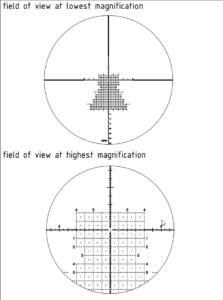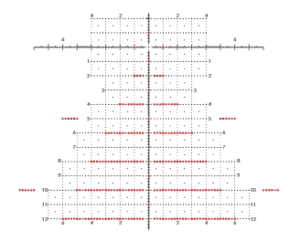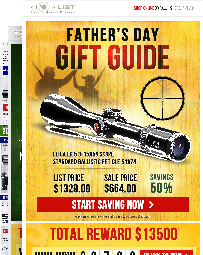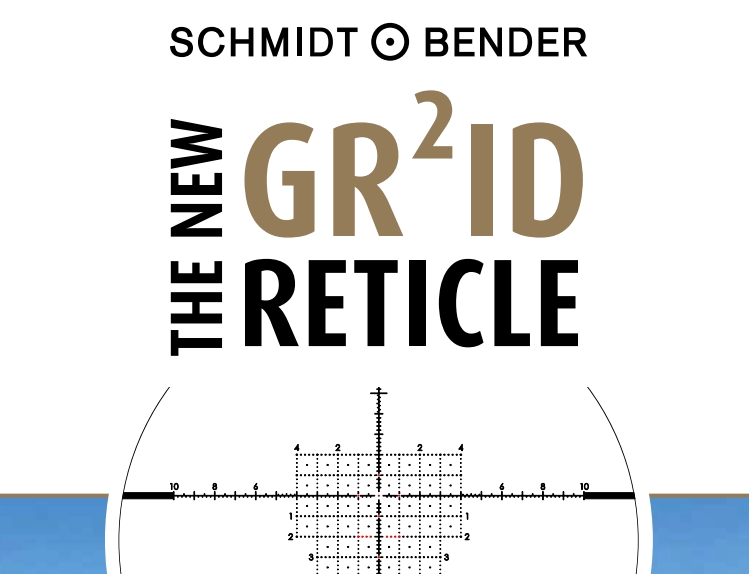Table of Contents
Schmidt Bender has designed a new GR²ID reticle for serious practical precision rifle competition shooters. This new reticle has been designed in association with Practical Long Range Sports Competitors. It comes with features that help to solve many problems of competitors in PRS stage.
The new GR²ID reticle reduces the clutter to a minimum and also tries to provide as much information to the competitor as possible. It tries to strike a balance between:
- Wide focus – For awareness and clarity
- Tight focus – For detailed information
New GR²ID Reticle – Design

Design of the new Schmidt Bender GR²ID reticle has 4 distinct features:
- Base Reticle
- Ballistic Grid
- Hold Over/Under Grid
- Illumination Tree
Let’s check the distinct aspects of these 4 features more closely.
1. Base Reticle
The Base reticle of the new GR²ID reticle is built upon the popular p4Fein. The Schmidt Bender reticle designers have retained the 0.035 MRAD main crosshair line thickness (found in p4Fein reticle) throughout the GR²ID reticle’s subtension details.
Different sections of the base reticle are given below:
- Horizontal Crosshair
- Vertical Crosshair
- Independent Central Dot
- Range Estimating Subtension
A. Horizontal Crosshair
- For fast acquisition of the target, the reticle designers have incorporated 0.5 MRAD subtension (0.1 MRAD high) above the crosshair.
- For enabling PRS shooters to get more accurate wind hold offs, the reticle design has been incorporated with 0.2 MRAD subtension (0.075 MRAD high) below the crosshair.
- Heights are low as well as unobtrusive. However, it still provides enough details when needed.
B. Vertical Crosshair
- To provide more accurate hold-overs, the vertical crosshair comes with 0.2 MRAD subtension (0.15 MRAD wide) down to 14 MRAD.
- For faster acquisition of target, the vertical crosshair has been incorporated with wider 1.0 MRAD subtension (0.4 MRAD wide).
C. Independent Central Dot
This has 3 parts:
- A central dot of 0.05 MRAD size.
- 5mm at 100m
- For measuring wind hold off, 0.2 MRAD gaps are there on either side.
D. Range Estimating Subtension
- On both vertical and horizontal crosshairs, 0.1 MRAD subtension is added between 4 and 5 MRAD.
- Once the vertical crosshair extends above 14 MRAD, the subtension becomes 0.5 MRAD.
- It continues till 30 MRAD.
2. Ballistic Grid
The ballistic grid of Schmidt Bender’s GR²ID reticle is carefully balanced by the reticle designers. It has been designed in such a way that the competition shooter can determine elevation and windage quickly. In fact, the ballistic grid section of the reticle is light as well as uncluttered. That’s why it is easy to see through.
The different features of the ballistic grid are:
- The grid’s horizontal dot pattern consists of two sizes of dots.
- At every 0.2 MRAD on the horizontal dot pattern, 0.06 MRAD sized dots are present.
- At the 1 MRAD markers, larger dots (of size 0.08 MRAD) are present. This helps to identify the line.
- The grid’s vertical dot pattern consists of 0.04 MRAD sized dots. These dots are unobtrusive in nature. The PRS competition shooters can distinguish these dots in any shooting condition. They can find these dots even under tight focus so that they can get the precise vertical hold-over estimation.
- You will find elevation numbers are mentioned on both sides of the grid in 1 Mil increments. This helps the shooters by reducing the searching time for holdover references.
- The reticle designers of Schmidt and Bender have included indicator lines on the outside of the grid at 5 MRAD and 10 MRAD. This further helps in major holdover reference acquisition quickly.
- The Ballistic Grid pattern is designed in such a way that it helps the PRS shooter in covering the ballistics of a 308 175gn @ 2580fps out to 900m in a full value 25 mph crosswind. If you are using more efficient calibers (like 6.5mms or 6mms), the shooters will get enhanced usefulness of the grid over 1,100m.
3. Hold Over/Under Grid
This section is the newest addition to the GR²ID reticle. Hold over/under grid section is especially handy for the Practical Precision Rifle Competitors. To hit a mid-range target, the competition shooters may need to dial out the elevation and windage for using the reticle to engage multiple targets in a stage for holding over/under.
This new feature enables the PRS shooters to achieve faster stage times. It is achieved because of the fact that the shooters have to dial less and at the same time remember less. Therefore, the system is now extremely fast and at the same time much simpler. This facility ensures that the shooter can give more time in finetuning other factors such as wind indicators and other fundamentals.
4. Illuminated Tree

Practical Precision Rifle Matches are held mostly during day time. Therefore, illumination is generally not required. That’s why the reticle has been provided with separate colored dots (black and red). This feature helps in separating information within the reticle. It provides shooters with more information and also doesn’t increase the clutter.
The illuminated region has two types of application features:
- The illuminated dots form a diamond constellation around the central dot (located at the top of the illuminated tree). This helps in locating the reticle’s center in peripheral vision. It ultimately helps to bear the crosshairs onto the target while the focus is maintained on the target.
- The illuminated tree pattern helps to acquire MRAD hold over points (within the grid pattern) faster. 3 sub-designs are present here:
- 0.06 Mil illuminated dot replaces each odd number vertical MRAD subtension line.
- For creating a tree-based pattern, at each even number MRAD reference line, the horizontal dots are illuminated. Therefore, shooters can acquire hold values faster. In fact, it also acts as a tree for indicating the location of the reticle center.
- To provide further reference points to the PRS shooters, the 5 MRAD and 10 MRAD indicator lines are illuminated.
Which Schmidt and Bender 5-25×56 PMII Models comes with GR²ID Reticle?
The new GR²ID reticle is available with these Schmidt Bender PMII 5-25×56 models:
Highlights:
- 34mm Main Tube Size
- Elevation Turret: Double Turn (DT), More Tactile Clicks (MTC), Locking Turret (LT), 0-26 MRAD
- Windage Turret: Single Turn (ST), Zero Stop (ZS), Locking Turret (LT), ±6 MRAD
- Counter Clockwise (CCW) Scope Turret Rotation, 1cm CCW Click Value
- Side Focus Parallax Adjustment (10m to infinity)
- RAL8000 Scope Finish
Highlights:
- 34mm Main Tube Size
- Elevation Turret: Double Turn (DT), More Tactile Clicks (MTC), Locking Turret (LT), 0-26 MRAD
- Windage Turret: Single Turn (ST), Zero Stop (ZS), Locking Turret (LT), ±6 MRAD
- Counter Clockwise (CCW) Scope Turret Rotation, 1cm CCW Click Value
- Side Focus Parallax Adjustment (10m to infinity)
- Pantone 7504M Scope Finish
Highlights:
- 34mm Main Tube Size
- Elevation Turret: Double Turn (DT), More Tactile Clicks (MTC), Locking Turret (LT), 0-26 MRAD
- Windage Turret: Single Turn (ST), Zero Stop (ZS), Locking Turret (LT), ±6 MRAD
- Counter Clockwise (CCW) Scope Turret Rotation, 1cm CCW Click Value
- Side Focus Parallax Adjustment (10m to infinity)
- Matte Black Scope Finish
Highlights:
- 34mm Main Tube Size
- Elevation Turret: Double Turn (DT), 0-26 MRAD
- Windage Turret: Single Turn (ST), ±6 MRAD
- Side Focus Parallax Adjustment (10m to infinity)
- Counter Clockwise (CCW) Scope Turret Rotation, 1cm CCW Click Value
- Matte Black Scope Finish
Downloads
- Schmidt Bender GR²ID User Manual – Download PDF
- Schmidt Bender GR²ID Datasheet – Download PDF
Conclusion
Schmidt Bender has incorporated this new reticle in the first focal plane (FFP) of top seller PM II 5-25×56 models. GR²ID reticle will be made available in other models in the future.




